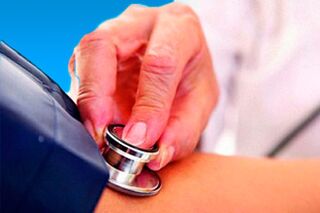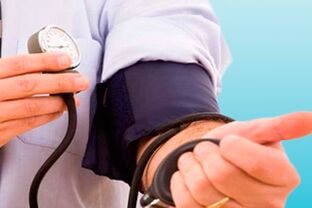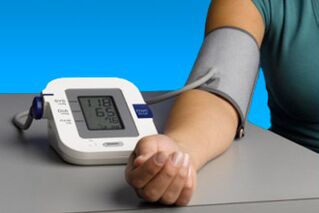
Violation of blood pressure provokes the failure of the whole organism. Although this disease is not completely treated, the course of the disease may be less noticeable and problematic for the patient.
Arterial hypertension is a chronic disease associated with increasing pressure on the vein walls. In this case, it is very important to distinguish the pressure of a person and to distinguish rare situations when this disease is a real manifestation. One-time growth may occur for various reasons and does not repeat often soon. The cause of a person can be the excitement of hormonal malfunction or injury.
Asking what the arterial hypertension is, it is necessary to fight the term "hypertension". This is a temporary increase in blood pressure above 140/90. However, in medicine, hypertension is called a situation where there is a stable high indicators of a person. Rarely fall below these numbers.
The downside of this disease is that not only the cardiovascular system suffers from chronic high blood pressure. There is something like target bodies in medicine. The essence of the problem is constantly growing blood pressure into a number of bodies - a negative impact on the heart, kidneys, brain and retina. The disease will have a negative impact on the whole body, but they are suffering in the first place. Even the principle of the classification of the disease depends on which body is negative.
There are various forms that depend on the classification of the principle of the disease. They can depend on the origin, the course and blood pressure level. The easiest form of arterial hypertension is the easiest because patients can learn at home pressure.
Like other diseases, hypertension has a few degrees that only aggravated only without the necessary treatment. There are norms that help determine the stage of the disease. You cannot conclude after one or two of the pressure of a person, because this approach can give incorrect indicators. Previously, a person had certain medications or emotional growths and many emotional could change indicators, which were not bad or good. This will not allow the patient to see the real picture of the health.
Do not mix the high blood pressure in the normal range with how the arterial hypertension looks like. 120/80 pressure is considered normal for the human body, but pressure can also be classified as 129/84. The pressure is considered to be increased by 139/89, but not classified as a degree of hypertension. Hypertension is considered a pressure from 140/90.
Table 1. The degree of hypertension and pressure level
| Norm | From 120/80 to 139/89 |
| 1 degree hypertension | From 140/90 to 159/99 |
| 2 degree hypertension | 160/100 to 179/109 |
| 3 degree hypertension | From 180/110 and above |

Along with the definition of hypertension and the classification of the disease, there is a single for primary and secondary hypertension. It develops as a preliminary independent pathology, in this case, other problems in the human body were often found. If we are talking about the second hypertension, it is the result of the existing diseases in the human body.
The disease is considered a slight form of blood pressure, 160/100 and attacks, mainly attacks without serious results. The arterial hypertension of the 1st degree is characterized by spasmodic disorders that occur in the work of the heart. Screening periods can be rare that it can be rare, but a small manifestation of the disease and suffers quite easily by the patient due to a chronic course. Separation is an alternative to normal indicators, and during this period does not feel the symptoms of the sick disease.
To assess the situation at the required level, you need to conduct pressure measurements using a tonometer several times a day. Usually, this is done three times a day when there are no other reasons that can affect a short change in emotional explosions or blood pressure.
The arterial hypertension of the 1st degree, patients often have their own symptoms that cannot take seriously. The disease can manifest itself with headache, fast heartbeat or pain on the left side of the sternum. Often patients are rarely characterized by symptoms of first-degree hypertension.
But even a little hypertension can be their own complications, which are full of serious disorders in the human body. This is:
- Brain microinfarch;
- Heart muscle hypertrophy;
- nephrosclerosis.
It is wrong to assume that the arterial hypertension of the 1st degree is treated with drugs. A patient suffering from first-degree hypertension can be claimed to have the risk of complications. Stats indicate about 15% of this probability.
When the patient was diagnosed with a 1st degree hypertension, the situation is as follows: high blood tissue can be used high blood pressure on the ship, which causes insufficient nutrition. In the absence of normal amounts of food and oxygen in cells, necrosis is developing. Initially, this process is not noticeable, but over time, some bodies in the patient's body and only certain cells can occur in time. The lack of treatment provokes anaudible shot.
If the high pressure of the patient is high, even grade 1 hypertension, gives a very high risk to develop heart problems.
The greater change of indicators, gives the blood in addition to the heart of the ships to push the ships with the narrow gaps. Everyone knows, the addition, the muscles will start to grow, it is also with heart tissues. Tier 1 risk reduces the risk of hypertension, because the heart can pour blood more effectively, but this is not completely true. Cardiomyopathy can even death by squeezing ships nearby.

In the second degree of arterial hypertension, the patient will be at 180/110 mm hg. In this case, patients in patients are greater than the hypertension of the 1st degree, the risk of complication less often.
Secondary hypertension, the pressure is extremely rarely, can be reduced, decreased, but cannot reach the allowable limit. Typically, the 1st degree has a hypertension, the 2nd grade to the same diseases, then it is possible to determine the appearance of benign or malignant arterial hypertension. What the arterial hypertension bears to clarify what the carriage is and risks help the development of pathology.
In patients, problems with vascular failure, hyperemia, hyperemia, vision and hypertensive crises are already added to familiar symptoms. The problem of the latter is that the pressure can drastically change the patient with 59 units that negatively affect the body. In the second degree of hypertension, complications are possible:
- Brain thrombosis;
- Aorta Anevrysm;
- atherosclerosis;
- angina pector;
- Enseefalopathy.
The feature of this degree in hypertension is the defeat of the target. In patients with such a diagnosis, bleeding in one of the organs. This is later due to arterial hypertension, the loss of past elasticity of blood vessels and it may be easier to crumble. The formation of blood clots on the walls of the blood vessels also has serious risks in the walls of the reduced lumen.
The arterial hypertension can receive sick disability due to serious problems that may occur in the second degree. They give the most 3 groups. However, this does not mean that the patient measures the pressure several times and is more than the permitted norm. The commission takes into account the consequences of this disease, collects information about hypertension, as well as information about the patient's working conditions - we can only talk about making cash saves.
The commission takes into account the consequences of this disease, collects information about hypertension, as well as information about the patient's working conditions - we can only talk about making cash saves.
The paradox of the situation, some patients are trying to buy this assistance in the first symptoms, while others hide their disease. Most, this is done by employees who will be fired due to working conditions that will trust this (more sick leave, annual leave). However, we must not forget that the secondary hypertension rate can lead to serious consequences that will aggravate an additional cargo disease.
It is necessary to note a special case possible in the second degree of arterial hypertension. When Malignies arrived in pathology, the commission can appoint 2 disability groups. Men over 60 years old, women aged 55, with irreversible flaws, patients with irreversible flaws found disability for life. This means that there is no need to pass the commission every year to confirm the status.
The degree of sickness can be determined by a person's pressure. When the indicators begin to reach extremely high proportions - 180/110 mm HG, the patient is diagnosed with third, heavy hypertension. In this case, complications are very serious, most of the medical service may cause death. It can be a shot, heart asthma, myocardium infarction, kidney failure and other diseases.
Patients assessing the seriousness of this degree are assigned to 1 group of disability. Assessing the degree of development risk of diseases should be rehabilitated without the patient fail. There is no need to talk about the treatment of this degree, but this approach will help prevent death before time.
There is a fourth degree hypertains concept. In this case, a person's help is very difficult to have a practical death. Medications help lighten the symptoms and reduce pressure levels. Hypertonic crises are pronounced and very often.
Typically, the disease and risk rate is displayed when diagnosed with the patient. This indicator can affect age, breed, obesity, bad habits and other factors.
There are four degree risk. The most optimal hypertension of risks of grade 1 is less likely to develop side diseases, less than 15%. Rank 1 is one of the most popular diagnoses of hypertension (Risk 2). This is due to a little patient who will not make the patient's disease difficult in any way. The arterial hypertension of the 1st degree is diagnosed (Risk 2), the probability of complications varies from 15% to 20%.
The risk of 3 degrees is 20-30% of the development of disease. Is called high. There are 4 degrees when pathologies are more than 30% of the likelihood of development. All forecasts of the risk rates are calculated in the absence of a patient's lifestyle change in the next 10 years.
Depending on the lesion of the patient's internal organs, doctors show the stages and rates of hypertension due to indicators. The stage of the disease determining which authorities are damaged.
The 1st phase of the disease, in fact, there is no indicator, because only the pressure increases and the human bodies are not damaged. The patient will have optimistic forecasts for the patient with a phase 1.
In 2 stages of the disease, the first signs of the ship contraction are found, the plaque appears and the creatine in the blood plasma. All changes in the internal organs can generally prevent serious changes and correct treatment and complications.
Unlike the 2nd stage, the third is characterized by special diseases, not only partial changes. This is an excellent hypertension, which arises from patients, myocardial infarction, stroke, heart and kidney failure and other characteristic diseases and other characteristic diseases.

Arterial hypertension is common in the world and is most common in highly developed countries. First of all, this envisages the communication with a large number of people, and this constantly leads to different emotions that cause pressure.
It's not difficult to answer the question of what it is for many? The spread of the disease allows this pathology to call the plague of the 21st century. There is something like an arterial hypertension syndrome, it is the same hyphenate, chronic vein lack. This is violations in the work of ships provoking arterial hypertension syndrome.
Gestational arterial hypertension is extremely negative for a woman. The appearance of this pathology is associated with pregnancy, in this period, a woman is contraindicated in taking most medications.
At the same time, the lack of treatment can lead to extremely negative consequences. Statistics show that gestational arterial hypertension is the cause of a third of the deadly consequences of the mother during childbirth, and this can cause the death of fetus or premature birth.
It is necessary to hospitalize the patient's symptoms of hypertension and what it is necessary to treat the disease in the first stage. It is necessary to consult a doctor who is involved in the increase in dose or involving other drugs. Self -Medication can aggravate the disease.























